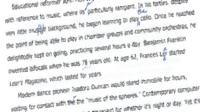| |
Writing Effective Product
Descriptions Can Be Fun!
by Marcia Yudkin
Once you learn a few fundamental principles and techniques, writing persuasive catalog copy, web copy or product descriptions for printed brochures or sales sheets becomes an easy, enjoyable process.
Step 1. List features and benefits, then connect them.
If you've read anything about copywriting, you've heard about the importance of including the benefits of products as well as their features. For instance, when you say your widget is a 2-inch pink plastic paperclip, you are describing its features. When you say it enables you to color-code stacks of papers or it attracts attention on someone else's desk or it makes a great gift for your organized-like-mad teenager, you are describing its benefits.
For concise, interesting product descriptions in a printed or online catalog, it's essential to combine features and benefits, weaving them together tightly yet unobtrusively. Here's a sample excerpt from the print catalog The Territory Ahead, mixing features and benefits:
Over cobblestone or dirt, concrete or causeway, the compression-molded midsole and metatomical footbed provide all-day, all-terrain cushioned support. (In other words, supreme comfort like we've never seen in a huarache.) Keen's patented bumpered toe prevents stubs and smashes. The traditional, tire-styled outsole features linen fabric inlay for additional strength and flex.
The widget's feature X gives you benefit Y. In one way or another (and there are at least 16 different ways to make this connection), this forms the foundation of catalog copy.
|
Overwhelmed by
Having to Describe 17 (or 1,777)
Products?
Never be brain-dead again when it comes
to making items sound distinctive and
tantalizing. This how-to manual and
brainstorming guide comes to the rescue,
with the keys to effective product
descriptions for print or online
catalogs or sales pieces.
Write catalog copy
easily.
|
Step 2. Brainstorm angles and choose one as your opener.
Almost always, you'll also need an attention-getter for the headline and first sentence of your product description. Use the checklist at the top of this page, or the expanded one in 73 Ways to Describe a Widget, described below, to come up with an interesting way to think about the item. For instance, The Territory Ahead actually starts the product description quoted above with this answer to the question, "Who is it for?":
Ultralightweight, anatomically logical and muy guapa, Keen's huarache overhaul was done with the global wanderer in mind.
You can weave other elements from this brainstorming into your descriptive copy as space allows.
Step 3. Polish up your descriptions in a consistent voice.
Did you notice the way that the writing from The Territory Ahead has personality? Technically, this element is called voice, and it's what unifies the descriptions at a web site or in a catalog so that they have a corporate identity. When there's a tight match between the writing voice and the customers' interests and needs, the shopper feels the company is speaking directly to them, and that they're looking at the kind of widgets they'd most like to buy.
While the samples above from The Territory Ahead have a kind of masculine romance about them, a catalog or web site's voice could be efficient, technical, playful, practical, compassionate, soulful... There are a zillion possibilities.
 |
Improve Your
Proofreading
Quick online course teaches how to
catch pesky typos. Whether you check
writing on screen or on paper, learn the
stakes for error-ridden copy, the five
best proofreading methods and the tools
you can or shouldn't use to identify
errors. Includes practice tests and
answers.
Proofreading Hacks course. |
Whatever the voice chosen, it must be consistent throughout the catalog or web site, or prospective customers get confused.
Step 4. Proofread, checking details.
As with any marketing or sales piece, the last step consists of proofreading, to make sure that you've included all the elements that people need to know before making a buying decision - size, color, composition, weight, price, etc. - along with making sure that the details provided are accurate.
Four steps - that's all there is to mastering the art of tantalizing product descriptions for catalogs or web sites.
Copyright 2013
Marcia Yudkin. All rights reserved.
|
Get to the Point Quickly. Enuff Said?
Eliminate wordiness. Learn how to get your point across in one page or how to satisfy a strict word count for magazine or newsletter editors. Discover how to identify and cut repetition, slash excess verbiage, make your point fast and convey a wealth of facts in a small space. My longwinded clients asked for this!
Become more
concise and pithy. |
Online Courses That May Interest You
The Sales Letter Makeover Course
The Press Release Makeover Course
The Mighty Postcard Marketing Course
Launch Your Information Empire
Create a Practical Marketing Plan
Fact Checking Made Easy |





